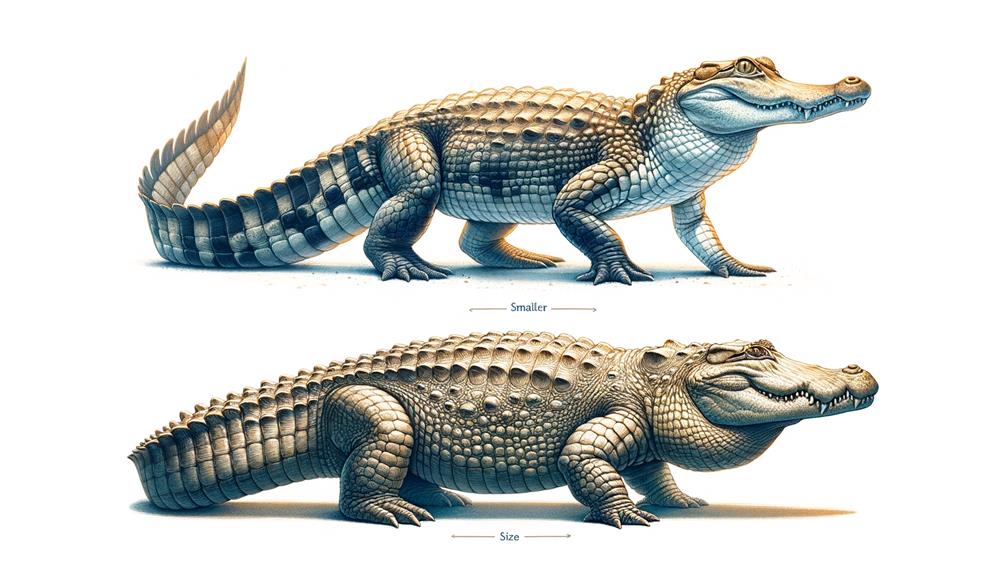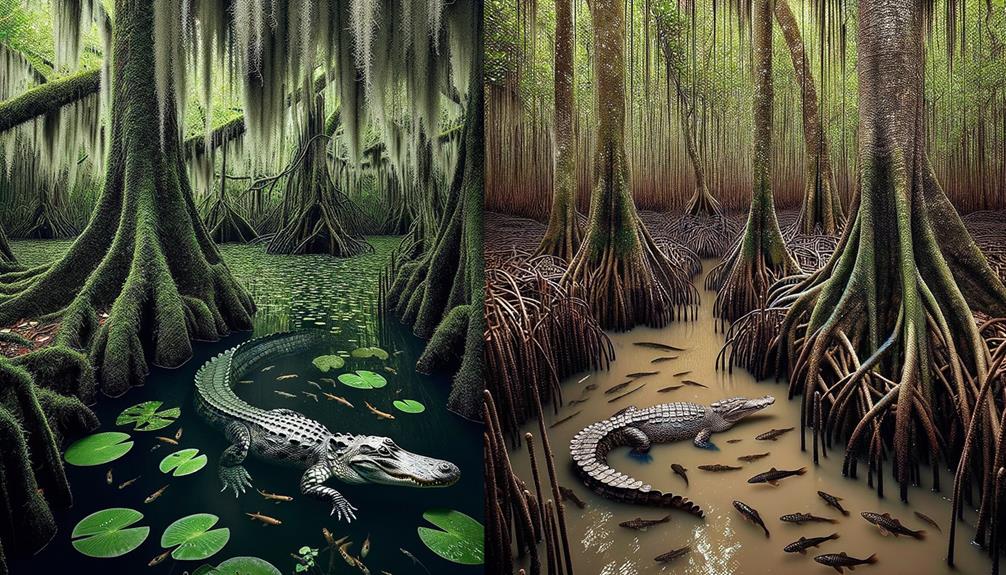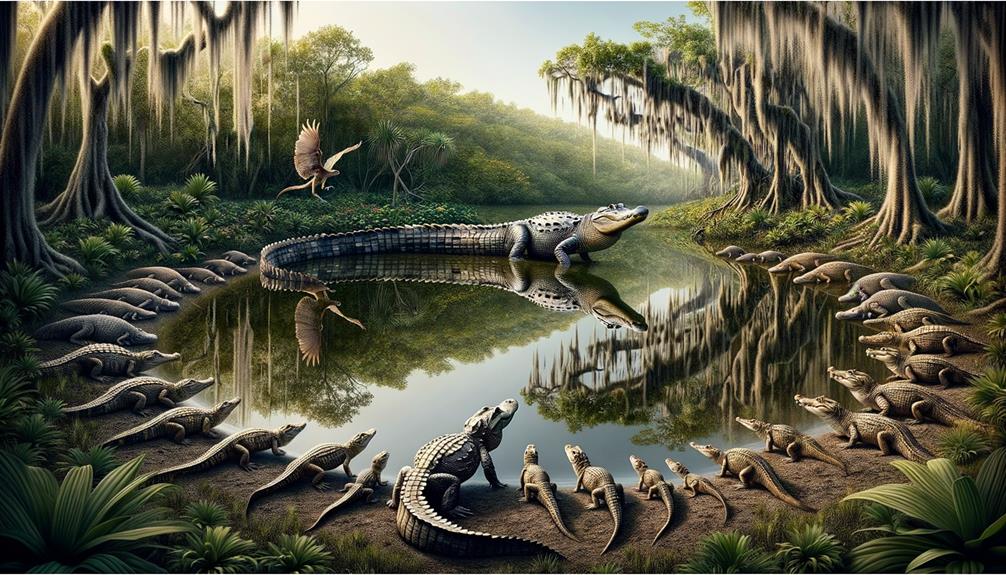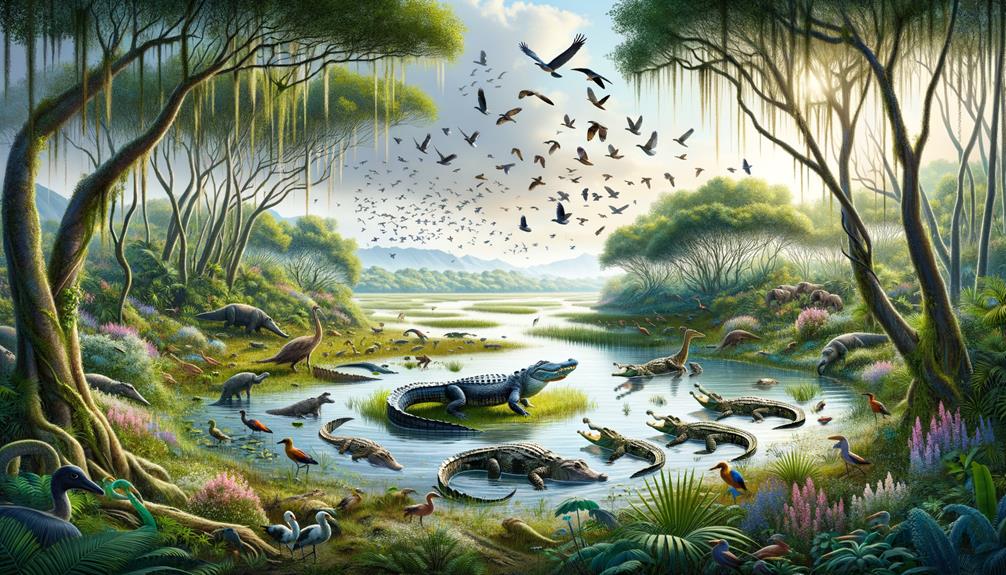Alligators and crocodiles have some striking differences that set them apart. Alligators sport wide, U-shaped snouts and tend to be darker, often appearing black or grey. In contrast, crocodiles have narrower, V-shaped snouts and typically show a greenish-brown hue. Size is another key distinction: crocodiles can grow up to about 20 feet and tip the scales at over 2,000 pounds, while alligators max out around 15 feet and 1,000 pounds. You'll mostly spot alligators in freshwater areas across the southeastern United States, but crocodiles are adaptable to both fresh and saltwater environments worldwide. Their unique behaviors and preferred habitats offer a window into their distinct biological traits. There's still much to learn about these fascinating reptiles.
Physical Characteristics
Spotting the difference between alligators and crocodiles starts with their snouts. Alligators have wide, U-shaped snouts, while crocodiles sport narrower, V-shaped ones. This isn't just about looks; it reflects their different hunting styles and preferred meals.
Looking at their jaws, alligators have a wider upper jaw, creating an overbite. When they close their mouths, you can't see their bottom teeth. Crocodiles, on the other hand, have more evenly aligned jaws. Their fourth lower tooth sticks out and fits against the outside of the upper jaw, visible even when their mouths are closed.
These jaw differences aren't just for show. Alligators, with their stronger bite, are built to crush prey. Crocodiles' jaw structure lets them grab a wider range of food. Color-wise, alligators tend to be darker, often black or grey, while crocodiles are usually greenish-brown.
Understanding these physical traits helps tell these two reptiles apart. It's not just about identification; it's about appreciating how these ancient creatures have adapted to their environments over millions of years.
Size and Weight

Alligators and crocodiles differ significantly in size and weight. Your average adult alligator stretches about 10 to 15 feet long and tips the scales between 500 and 1,000 pounds. Crocodiles, on the other hand, can grow to a whopping 20 feet and often weigh more than 2,000 pounds. These size differences play a big role in how these reptiles behave and where they choose to hang out. The bigger crocs tend to need more space and different habitats compared to their slightly smaller alligator cousins. It's fascinating to see how these physical traits shape their lives in the wild.
Average Adult Length
Adult alligators usually stretch out to 10 to 15 feet, while their crocodile cousins can reach an impressive 14 to 17 feet. This size gap between these reptiles is pretty noticeable. Take the American alligator, found in the swampy southeast of the U.S. – it rarely grows beyond 15 feet. But the saltwater croc, the big kahuna of the bunch, often hits 17 feet or more.
These size differences tell us a lot about how they live. Alligators, being a bit smaller, tend to hang out in cozy freshwater spots. Crocodiles, especially the saltwater variety, thrive in bigger, saltier waters, which might explain why they grow so large.
Looking at these differences shows how each species has adapted to its surroundings. The American alligator's stocky build is perfect for ambushing prey in murky waters. Meanwhile, the saltwater crocodile's long body helps it cruise through vast ocean stretches. Understanding these quirks makes you appreciate these incredible creatures even more.
Typical Weight Range
Alligators and crocodiles pack a hefty punch, tipping the scales between 225 to 450 kilograms. This range reflects their unique lifestyles and habitats. American alligators, often found in freshwater swamps, rivers, and lakes, tend to weigh less. Their diet, while plentiful, doesn't usually include the massive prey that would bulk them up significantly.
In contrast, American and Nile crocodiles, which frequent saltwater or brackish environments, often weigh more. Their access to larger prey contributes to their heavier build. The weight difference between alligators and crocodiles isn't just about diet; it's also a result of how they've adapted to their surroundings over time.
A quick breakdown of typical weight ranges:
| Species | Typical Weight Range | Habitat |
|---|---|---|
| American Alligator | 225 – 360 kg | Freshwater |
| American Crocodile | 360 – 450 kg | Saltwater/brackish |
| Nile Crocodile | 360 – 450 kg | Freshwater/saltwater |
These weight differences showcase how these impressive reptiles have evolved to thrive in their specific environments. Understanding these variations gives us a glimpse into the fascinating world of these ancient creatures and how they've adapted to survive in diverse ecosystems.
Habitat and Distribution

Alligators and crocodiles inhabit different parts of the world, each carving out their own ecological niches. You'll find alligators mainly in freshwater areas across the southeastern U.S. and parts of China. Crocodiles, on the other hand, have a wider range. They're at home in both fresh and salt water, spanning Africa, Australia, Southeast Asia, and the Americas. These reptiles have adapted to various climates over time, becoming the top predators in their respective ecosystems. The geographic spread of these ancient creatures highlights their resilience and ability to thrive in diverse environments, from swamps to coastal regions.
Geographic Regions Covered
Alligators and crocodiles have carved out distinct territories across the globe. Alligators mostly stick to freshwater spots in the southeastern U.S. and China, while crocodiles spread their wings a bit more. You'll find these scaly creatures in Africa, Australia, Southeast Asia, and the Americas.
In the U.S., alligators are the stars of states like Florida, Louisiana, and Texas. They're right at home in freshwater marshes, rivers, and lakes. Their cousins, the American crocodiles, prefer the coastal areas of South Florida and parts of Central and South America. These guys aren't picky – they're cool with brackish waters and can even handle saltwater, giving them more options for setting up shop.
Crocodiles don't stop there, though. They've made themselves comfortable in the Nile River, northern Australia's salty waters, and all over Southeast Asia. It's pretty impressive how these creatures have adapted to such different environments.
This wide-ranging distribution tells us a lot about how alligators and crocodiles have evolved over time. They've each found their niche, adapting to specific habitats that suit their needs. It's a testament to their survival skills and ability to thrive in various ecosystems.
Preferred Water Types
Alligators and crocodiles have distinct preferences when it comes to their watery homes. Alligators stick to freshwater, hanging out in rivers, lakes, and swamps. They're particularly fond of the southeastern United States, where these habitats are plentiful.
Crocodiles, however, aren't so fussy. You'll find them in all sorts of places, from murky estuaries to the open sea. This flexibility is why crocodiles are spread out across more parts of the world than alligators.
A few key differences stand out:
- Habitat Range: Crocodiles can live in both fresh and salt water, giving them more options for where to set up shop.
- Protection Strategies: Keeping alligators safe means focusing on specific freshwater areas, while crocodile conservation needs a broader approach.
- Behavior: Crocodiles tend to be more aggressive than alligators, possibly because they deal with more varied environments and competition.
These differences shape how we work to protect these ancient reptiles. By understanding their unique needs, we can create better plans to ensure their survival in our changing world.
Climate Adaptations
Alligators and crocodiles have distinct preferences when it comes to their watery homes, and their ability to handle different climates plays a big role in where they live and how they survive.
You'll mainly find alligators in the southeastern U.S. and China, hanging out in freshwater spots like swamps, rivers, and lakes. They're pretty tough when it comes to cold weather, much more so than their crocodile cousins. When temperatures drop, alligators go into a kind of winter sleep called brumation, which helps them tough out the chilly months.
Crocodiles, on the other hand, are more into the warm weather scene. They're spread out across tropical areas in Africa, Australia, Southeast Asia, and the Americas. Unlike alligators, crocs can handle saltwater thanks to special glands that get rid of extra salt. This neat trick lets them live in both freshwater and coastal areas, giving them a wider range of places to call home.
The way these two reptiles have adapted to different climates shows how they've evolved separately over time. Alligators have figured out how to deal with changing seasons, while crocodiles have become pros at living in all sorts of water environments, including the salty stuff. These differences not only explain where we find them today but also show off how versatile these ancient creatures really are.
Behavior and Temperament

Crocodiles and alligators differ significantly in their behavior and temperament. Crocodiles, especially saltwater species, tend to be more aggressive and active, particularly when hunting or defending their territory. They're known for attacking without provocation, likely due to their higher metabolism, which fuels increased activity and aggression. American crocodiles, however, are generally more reserved and seldom attack unless threatened.
Alligators, in contrast, are typically more docile. When humans approach, they often retreat rather than confront. Their shy nature means they usually avoid conflict unless cornered or feeling threatened. Both reptiles have excellent night vision, thanks to specialized eye structures, making them effective nocturnal hunters.
Key differences in their behavior and temperament include:
- Aggression: Crocodiles are generally more confrontational, while alligators prefer to avoid conflict.
- Attack patterns: American crocodiles rarely attack unprovoked, unlike their saltwater relatives.
- Energy levels: Crocodiles' higher metabolism contributes to their more active and aggressive behavior, especially when hunting.
Lifespan

Crocodiles and alligators are renowned for their impressive lifespans, which contribute to their status as living fossils. Crocodiles typically survive between 35 and 75 years, with some outliving even that range. In their natural habitats, they average about 50 years, while those in captivity often reach 50 to 60 years. Interestingly, these ancient reptiles don't show signs of aging as we understand it; their demise usually results from environmental factors or predation rather than old age itself.
Alligators don't quite match their crocodilian cousins in longevity, but they're no slouches either. Wild alligators generally live 30 to 40 years, while those in captivity can stretch that to 50 years. Some exceptional individuals have even made it to their 80s, showcasing the species' durability. Like crocodiles, alligators also seem to sidestep the typical aging process, with their lifespan largely determined by external conditions.
The endurance of these reptiles speaks volumes about their adaptability and evolutionary success. Their ability to thrive for decades in various environments underscores why they've remained largely unchanged for millions of years, continuing to dominate their ecological niches across the globe.
Conservation and Coexistence

Safeguarding crocodiles and alligators goes beyond preserving ancient reptiles; it's about maintaining the intricate balance of our ecosystems. These impressive creatures are vital to their habitats, managing fish populations and creating water sources used by other animals during dry spells. However, some species, like the Orinoco crocodile, face an uncertain future, making effective conservation efforts crucial.
Finding ways for humans and these reptiles to live side by side is key. Teaching communities about crocodile and alligator behavior can reduce conflicts and encourage safer interactions. Three main approaches to foster coexistence and conservation are:
- Protecting Natural Spaces: Keeping wetlands, rivers, and other habitats undisturbed is vital. These protected areas offer safe places for breeding and feeding.
- Public Awareness: Informing local residents about safety practices and the ecological significance of these reptiles can reduce fear and build respect for their presence.
- Conservation Initiatives: Backing programs that track populations, care for injured animals, and reintroduce captive-bred crocodiles and alligators to the wild can help boost their numbers.
Frequently Asked Questions
What Is the Main Difference Between an Alligator and a Crocodile?
Alligators and crocodiles may look similar at first glance, but there's a key feature that sets them apart: their snouts. Alligators sport wide, U-shaped snouts, while crocodiles have narrower, V-shaped ones. This distinction isn't just cosmetic; it reflects their different hunting and feeding habits. Interestingly, some crocodile species can live for more than seven decades, making them true survivors in the animal kingdom. Understanding these differences helps us appreciate the unique adaptations of these ancient reptiles.
Who Is Stronger, an Alligator or a Crocodile?
Research suggests crocodiles pack more punch than alligators. Their jaws clamp down harder, and their bodies are built with more muscle. This raw strength makes them tougher opponents in the wild, showing off nature's incredible power.
Does Florida Have Alligators or Crocodiles?
Florida's a unique place when it comes to reptiles. You might be wondering about the big, toothy creatures lurking in its waters. Well, here's the scoop: Florida's home to both alligators and crocodiles. Gators are the ones you'll spot most often, but if you're in the southern coastal areas, you could come across American crocodiles too. It's pretty rare to have both species in one place, which makes Florida special in the reptile world. So next time you're near water in the Sunshine State, keep your eyes peeled – you never know what scaly resident you might spot!
Why Are Crocs More Aggressive Than Alligators?
Crocodiles tend to show more aggressive behavior than alligators, largely due to their adaptation to tougher living conditions. This has led to stronger territorial instincts in crocs. Their evolutionary journey favored heightened aggression as a survival tactic, unlike alligators who typically inhabit more stable environments. It's quite an interesting distinction between these two reptiles.



